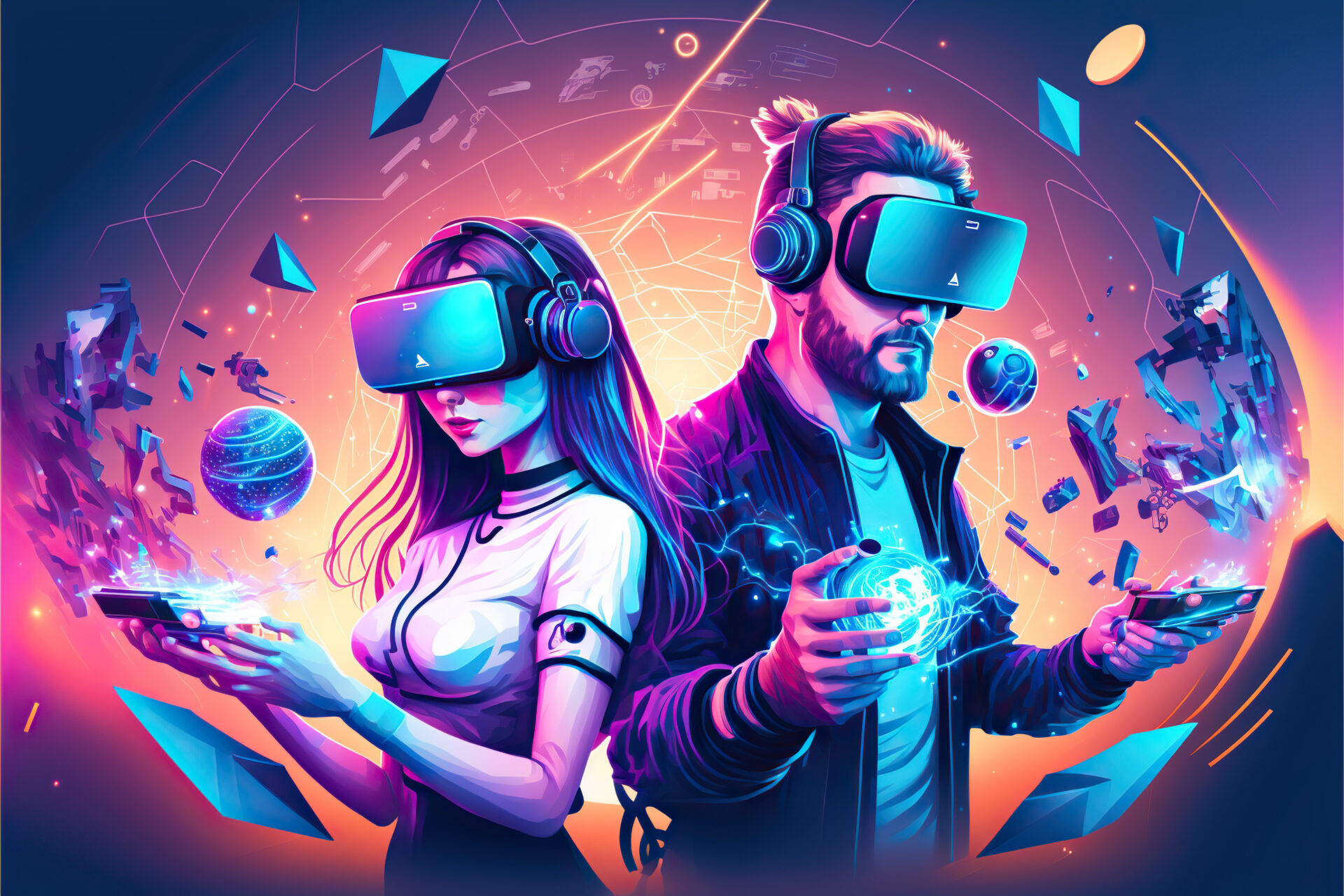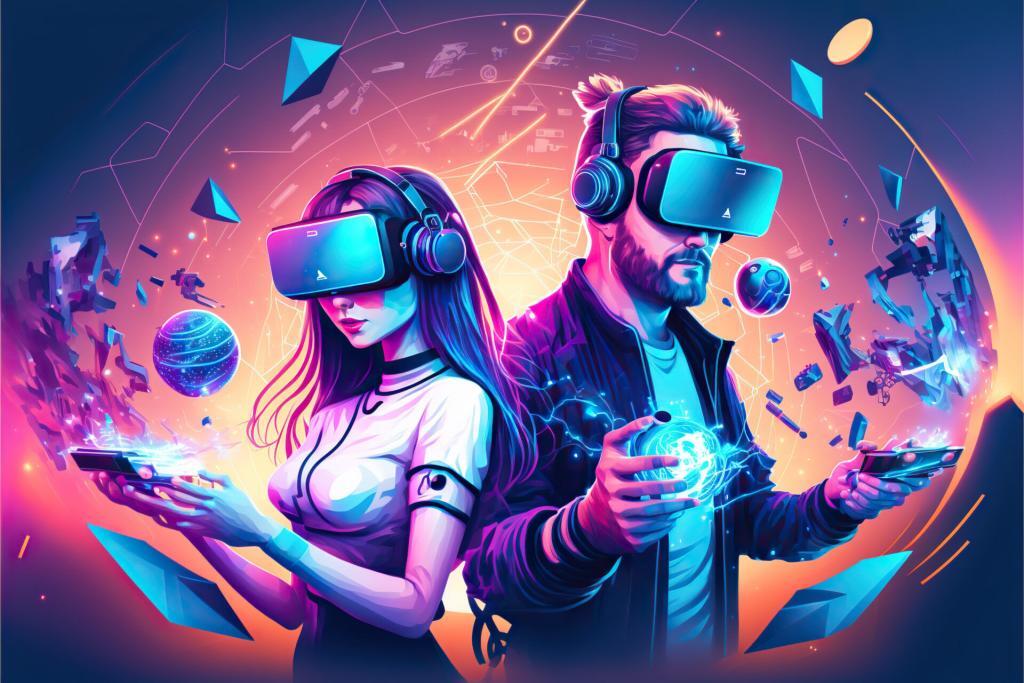eCommerce AI | Web Apps | AR/VR Software – ECA Tech
- Home
- The Rise of the Metaverse: 10 Best Things You Need to Know
The Rise of the Metaverse: 10 Best Things You Need to Know

September 15, 2024 - Technology
The metaverse, once a concept reserved for science fiction, is quickly becoming a reality. It’s a virtual universe where digital and physical realities converge, creating immersive and interactive experiences that redefine how we live, work, and play. Major companies are investing heavily in metaverse technologies, signaling that this digital frontier is set to become a significant part of our future. But what exactly is the metaverse, and what should you know about it? This article explores ten essential things you need to know about the rise of the metaverse.
- Immersive
- Interactive
- Significant
- Enhanced
1. What is the Metaverse?
The term “metaverse” refers to a collective virtual shared space that is created by the convergence of virtually enhanced physical reality and persistent virtual spaces, including the sum of all virtual worlds, augmented reality (AR), and the internet. Essentially, the metaverse is a digital universe where users can interact with each other and digital objects in real-time.
Think of the metaverse as an expansive, interconnected virtual world where people can work, socialize, shop, and play, just like in the real world. Unlike traditional online environments, the metaverse offers immersive experiences through technologies like virtual reality (VR) and AR, making interactions feel more lifelike and engaging.
In the metaverse, users are represented by avatars—digital representations of themselves—which can move freely through various digital spaces, from virtual cities to fantasy worlds. The concept of the metaverse has been popularized by novels like Neal Stephenson’s Snow Crash and films like Ready Player One, but it is now rapidly evolving from fiction to reality.
2. The Role of Virtual Reality (VR) and Augmented Reality (AR)
Virtual reality and augmented reality are the key technologies driving the development of the metaverse. VR immerses users in a fully digital environment, often using headsets that simulate a 360-degree field of vision, making users feel as if they are physically present in the virtual world. AR, on the other hand, overlays digital elements onto the real world through devices like smartphones or smart glasses, blending physical and virtual realities.
Both VR and AR are essential in creating the immersive experiences that define the metaverse. For example, in a VR-based metaverse, users can attend virtual meetings, explore digital landscapes, and interact with others in a fully immersive way. AR can enhance real-world experiences by adding digital layers, such as virtual art displays in a museum or 3D visualizations in an office setting.
As VR and AR technologies continue to improve, they will become more accessible and integrated into everyday life, making the metaverse more seamless and engaging for users. This technological convergence is set to revolutionize not only entertainment but also industries like education, healthcare, and retail.
3. Major Players in the Metaverse Space
Several tech giants and startups are vying to shape the metaverse, each bringing its vision and resources to the table. Meta (formerly Facebook) is perhaps the most high-profile company driving the metaverse’s development. With the rebranding of Facebook to Meta in 2021, CEO Mark Zuckerberg made it clear that the company sees the metaverse as the future of the internet and is investing billions of dollars to build it.
Other major players include Microsoft, which is focusing on enterprise solutions within the metaverse through its platform Mesh, and Google, which is exploring AR and immersive experiences. Gaming companies like Epic Games (creators of Fortnite) and Roblox Corporation are also making significant strides in creating virtual worlds that could form the foundation of the metaverse.
Beyond the tech giants, blockchain-based platforms such as Decentraland and The Sandbox are creating decentralized metaverses where users can buy, sell, and trade virtual real estate and assets using cryptocurrencies. These platforms represent a different vision of the metaverse—one that is user-owned and built on blockchain technology.
With so many players involved, the metaverse is likely to evolve as a collaborative ecosystem rather than a single, monolithic entity. The competition and innovation in this space are driving rapid advancements in metaverse technology and experiences.
4. Metaverse Economy and Virtual Real Estate
One of the most intriguing aspects of the metaverse is the emergence of a virtual economy, where digital assets and virtual real estate hold real-world value. In the metaverse, users can buy, sell, and trade digital items such as clothing for avatars, virtual art, and even virtual land. Platforms like Decentraland and The Sandbox have seen virtual real estate sales soar, with some parcels of virtual land selling for millions of dollars.
This virtual economy is fueled by blockchain technology, which enables the creation and ownership of unique digital assets known as non-fungible tokens (NFTs). NFTs represent ownership of digital items and can be bought and sold on various marketplaces, often using cryptocurrencies like Ethereum. These digital assets give users a sense of ownership and allow them to monetize their creations and contributions to the metaverse.
As the metaverse grows, so will its economy. Virtual goods, services, and experiences will become increasingly valuable, and new opportunities will emerge for businesses and creators to profit from this digital frontier. The metaverse economy has the potential to reshape industries such as real estate, art, fashion, and entertainment, blurring the lines between the physical and digital worlds.
5. Social Interaction and Community Building
The metaverse is poised to redefine how we socialize and build communities. In the metaverse, social interactions can occur in virtual environments that are far more immersive than traditional social media platforms. Users can attend virtual concerts, visit digital art galleries, or even just hang out with friends in virtual worlds that feel almost as real as physical spaces.
One of the key advantages of the metaverse is its ability to bring people together from across the globe in a shared, immersive experience. Virtual events, such as concerts and conferences, can attract massive audiences without the limitations of physical space. For example, virtual concerts held within Fortnite have drawn millions of attendees, demonstrating the potential of the metaverse to create new forms of entertainment and social engagement.
Additionally, the metaverse can foster new types of communities based on shared interests, rather than geographical proximity. These virtual communities can be centered around anything from gaming and art to professional networking and activism. The metaverse allows for a level of connection and collaboration that transcends traditional boundaries, enabling people to build meaningful relationships and collaborate in ways that were previously impossible.
6. Work and Collaboration in the Metaverse
The metaverse is not just about entertainment and socializing; it also has the potential to transform the way we work. With the rise of remote work, the metaverse could provide a more immersive and collaborative environment for employees to work together, regardless of their physical location. Virtual offices, meetings, and workspaces within the metaverse can mimic the experience of being in a physical office while offering additional tools and capabilities.
Platforms like Microsoft’s Mesh are already exploring the possibilities of metaverse-based workspaces, allowing employees to collaborate in 3D environments where they can interact with virtual objects and each other in real-time. These virtual workspaces could enhance productivity by providing more engaging and interactive ways to brainstorm, plan, and execute projects.
Moreover, the metaverse could revolutionize industries like architecture, engineering, and design by enabling professionals to create and manipulate 3D models in a shared virtual space. Teams could work together on complex projects from anywhere in the world, reducing the need for physical meetings and travel.
As companies continue to explore the potential of the metaverse for work and collaboration, it could lead to new ways of organizing and structuring the workplace, making it more flexible, efficient, and innovative.
7. Education and Training in the Metaverse
Education is another area that could be significantly impacted by the rise of the metaverse. Virtual classrooms and immersive learning experiences could provide students with more engaging and effective ways to learn. In the metaverse, students could attend lectures, participate in hands-on simulations, and collaborate with classmates in virtual environments that make learning more interactive and memorable.
For example, medical students could practice surgeries in a fully immersive virtual operating room, or history students could explore ancient civilizations through virtual reconstructions. These types of experiences can enhance learning by making abstract concepts more concrete and providing opportunities for experiential learning that are not possible in traditional classrooms.
Beyond formal education, the metaverse could also be used for corporate training and professional development. Companies could create virtual training programs that simulate real-world scenarios, allowing employees to practice and develop their skills in a safe and controlled environment. This type of immersive training could be particularly valuable in industries like healthcare, aviation, and manufacturing, where hands-on experience is critical.
As it continues to evolve, it could democratize access to education by providing high-quality, immersive learning experiences to anyone with an internet connection, regardless of their location or socioeconomic status.
8. Privacy and Security Concerns
As exciting as it may be, it also raises significant privacy and security concerns. The immersive nature means that vast amounts of personal data will be collected, from biometric information like facial expressions and body movements to behavioral data about how users interact with virtual environments. This data could be used for a variety of purposes, including personalized advertising, but it also raises concerns about surveillance, data breaches, and misuse.
Ensuring privacy and security will require robust data protection measures, including encryption, secure authentication, and transparent data usage policies. Users must be informed about how their data is being collected and used, and they should have control over their personal information. Additionally, companies operating in the metaverse will need to comply with data protection regulations, such as the General Data Protection Regulation (GDPR) in Europe, to ensure that users’ rights are respected.

Embracing the Future
The metaverse represents a transformative shift in how we interact with the digital world, blending virtual and physical realities in ways that were once the realm of science fiction. As the metaverse continues to evolve, it holds the potential to revolutionize various aspects of our lives—from social interactions and entertainment to work, education, and commerce.
However, with these new opportunities come challenges, particularly in terms of privacy, security, and the ethical use of data. Ensuring that the metaverse develops in a way that is safe, inclusive, and beneficial for all will require careful planning, robust regulations, and collaboration between governments, tech companies, and users.
As we stand on the cusp of this new digital frontier, understanding the metaverse and its implications is crucial. By staying informed and engaging with these emerging technologies, we can help shape it in a way that enhances our lives and creates new possibilities for connection, creativity, and innovation.
The rise of the metaverse is not just a technological advancement; it’s a cultural shift that could redefine the way we experience the world. Whether you’re an enthusiast, a business leader, or simply curious about the future, now is the time to explore the metaverse and consider how it might impact your life in the years to come.
By clicking Learn More, you’re confirming that you agree with our Terms and Conditions.

FAQ
1. What is the metaverse?
The metaverse is a fascinating concept that embodies a collective virtual shared space, intricately woven together by the harmonious convergence of virtually enhanced physical reality and the ethereal essence of physically persistent virtual reality. It serves as a boundless realm where the boundaries between the tangible physical world and the infinite possibilities of the digital realm blur, offering a dynamic and immersive experience for users to explore, create, and connect in ways previously unimaginable. As technology continues to advance, it stands as a testament to the infinite potential of human creativity and innovation in shaping the future of interconnected virtual realities.
2. How does it work?
It is built on a combination of technologies, including virtual reality (VR), augmented reality (AR), and mixed reality (MR). These technologies allow users to interact with digital content in a way that blurs the lines between the physical and digital worlds.
3. What can you do in the metaverse?
The possibilities are vast. You can:
- Socialize: Meet friends, attend virtual events, and participate in online communities.
- Work: Collaborate with colleagues, attend virtual meetings, and work remotely.
- Learn: Take online courses, attend virtual conferences, and explore educational content.
- Play: Experience immersive gaming, virtual sports, and other forms of entertainment.
- Shop: Purchase virtual goods and services, explore virtual storefronts, and try on clothes virtually.
4. How will it impact our lives?
The metaverse has the potential to revolutionize many aspects of our lives, including:
- Social interactions: Creating new ways to connect with others and build relationships.
- Work and education: Providing new opportunities for collaboration, learning, and remote work.
- Entertainment: Offering immersive and interactive experiences that go beyond traditional forms of media.
- Commerce: Creating new markets for virtual goods and services.
5. What are the challenges of building the metaverse?
There are several challenges to overcome including:
- Technical limitations: Current technologies may not be advanced enough to create a truly seamless and immersive experience.
- Interoperability: Ensuring that different platforms can communicate and interact with each other.
- Privacy and security: Protecting user data and preventing harmful activities within the metaverse.
- Accessibility: Making it accessible to people with disabilities.
6. When will it become mainstream?
The timeline for the widespread adoption is uncertain. It will depend on factors such as technological advancements, regulatory frameworks, and consumer acceptance. However, many experts believe that it could become a significant part of our daily lives within the next decade.
